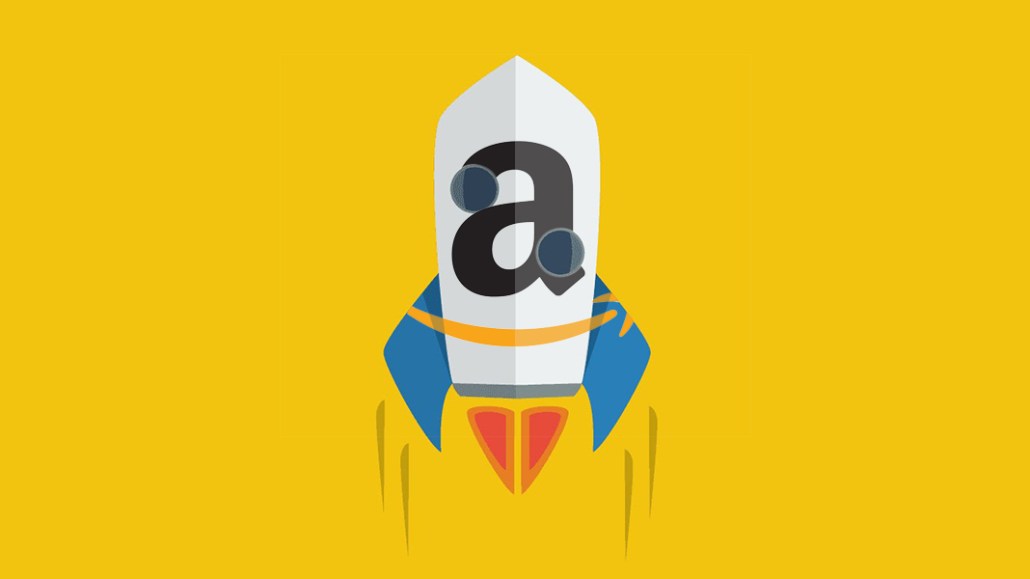
Amazon Advertising has grown up this year, a function of the company’s growing investment in its $1 billion-plus offering, but also increased attention from agencies and brands. We break down how the offering stands.
Amazon Marketing Services
- Offers self-serve, DIY, paid search media. Brands can have ads appear in headline search and product listings ads.
- Headline search ads are pay-per-click ads that appear at the top of search results. They’re targeted based on the terms shoppers search for. They’re open to both vendors who sell to Amazon and third-party sellers.
- Sponsored products appear on product pages and in scrollable modules. They’re also open to both vendors and sellers. One important thing to note that is unique to Amazon, since it sells product: If you run out of stock, the ads stop running, too.
- Product display ads aren’t targeted with keywords, but can appear, for example, on complementary product pages or even competitors’ products.
- Has an API in beta expected to go public next year that will let brands control things like spend through a single day and campaign management.
Amazon Media Group
- Offers more traditional ad buys that include Kindle, sponsorship, displays or out of home.
- A new offering this year was Amazon Video Ads, default sound off, that autoplay on Amazon sites or elsewhere.
- AMG can find “interest groups” across different sites, including IMDb.com, then help brands create takeovers and use ad space.
- AMG includes the Amazon Advertising Platform, which means campaigns can run across Amazon sites and third-party sites.
- Amazon opened up self-service for AMG this year, so agencies can manage their own campaigns and don’t have to go through Amazon.
- An API for sponsored product ads went live this year as well.
Advertising versus retail experience
Amazon differentiates ad products available through AAP, AMS or AMG from ways brands can enhance the appearance of their “storefronts.”
- Amazon Stores: Stores is a self-serve, DIY way for both vendors and sellers to make virtual “shopping” experiences. Brands can pick design templates and curate products.
- Standard A+: Vendors can sign up for A+ content, which Amazon says can increase sales from 3 to 10 percent. It essentially lets you include better photos and video.
- Enhanced/Premium A+: By invitation only, Premium A+ lets brands include seven modules (more than standard) and also inline banner videos, rotating banners, interactive highlights, comparisons and other souped-up features. An ad buyer said testing “comparisons” with other products led to 70 percent of customers buying the next highest price point.
Advertiser Audiences
This self-service tool went live in July. It is a way for Amazon to segment the shoppers on its website. Brands can match a list of customers with Amazon shoppers to make targeting segments to use in Amazon ad campaigns.
The numbers
- The minimum investment for AMG is $50,000.
- A+ pages cost about $250 per page but can go up depending on the brand’s size and the service level from Amazon.
- Premium A+ pages cost between $250,000 and $500,000 for unlimited pages.
Influencer marketing
Influencer marketing on Amazon is new, but the launch of Spark — a shoppable feed only Prime members can post to — this fall gave it a boost. That means brands don’t have a way in yet, but their influencers do.
The buyer view
“Brands need to be considering hybrid selling relationships with Amazon much more intensely. Many of our large clients are indeed doing this and have engaged us to help them understand how to best do that. Brands need to be looking at Amazon as a component of their overall branding strategy, both in the way they produce content for and buy presence on the platform.” said Tod Harrick, Marketplace Ignition vp of product. “To that end, they need to think carefully how they incorporate these pages as part of an overall traffic strategy.”
“Brands can’t treat Amazon as a shiny object,” said another media buyer. “Amazon is not the end-all, be-all to everything. If you don’t sell product on Amazon, from an ad perspective there’s no point either. They’re frenemies.”
More in Marketing

How brands shifted marketing and media strategies through year of tariffs
Marketers share how they navigated the maze of tariffs and regulatory changes this year.

Despite the hype, agentic AI isn’t ready to take the brand controls just yet
Despite agentic AI boosting content creation speed, human oversight remains critical due to concerns over hallucination, brand consistency.

Starbucks hires first-of-its-kind marketing role heading up fashion and beauty collabs
Neiv Toledano has joined Starbucks as its senior marketing manager of fashion and beauty.





